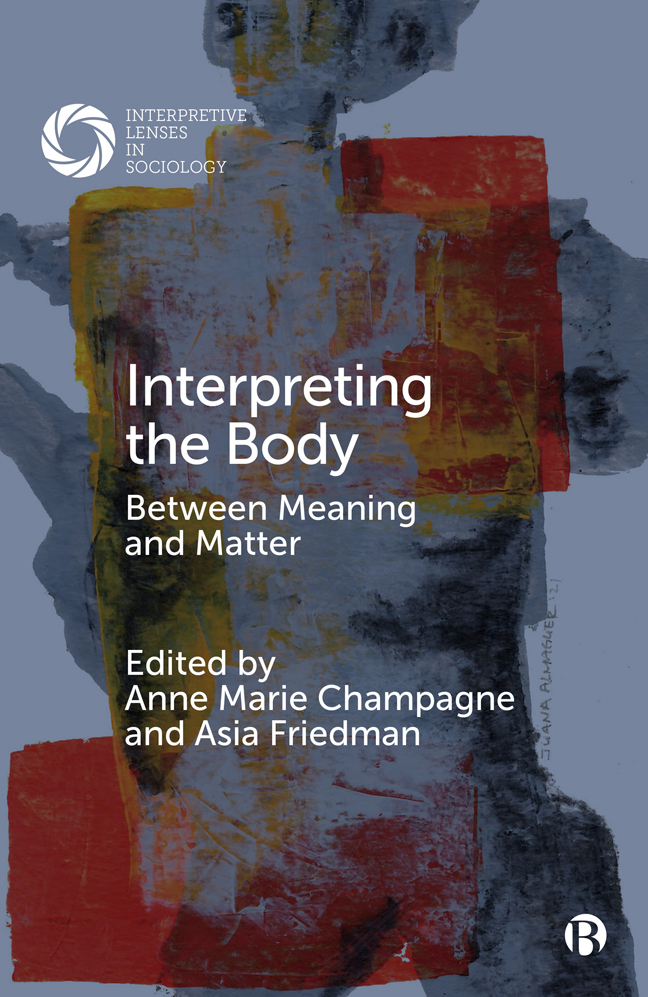Book contents
- Frontmatter
- Dedication
- Contents
- Series Editors’ Preface: Interpretive Lenses in Sociology—On the Multidimensional Foundations of Meaning in Social Life
- Notes on Contributors
- Preface and Acknowledgments
- Introduction: Between Meaning and Matter
- 1 Toward a Strong Cultural Sociology of the Body and Embodiment
- 2 Thinking the Molecular
- 3 Interpreting Africa's Seselelãme: Bodily Ways of Knowing in a Globalized World
- 4 Gender on the Post-Colony: Phenomenology, Race, and the Body in Nervous Conditions
- 5 Reinterpreting Male Bodies and Health in Crisis Times: From “Obesity” to Bigger Matters
- 6 Beauty, Breasts, and Meaning after Mastectomy
- 7 “You Are Not the Body”: (Re)Interpreting the Body in and through Integral Yoga
- 8 Black Girls’ Bodies and Belonging in the Classroom
- 9 Embodied Vulnerability and Sensemaking with Solidarity Activists
- 10 Our Bodies, Our Disciplines, Our Selves
- Index
6 - Beauty, Breasts, and Meaning after Mastectomy
Published online by Cambridge University Press: 23 January 2024
- Frontmatter
- Dedication
- Contents
- Series Editors’ Preface: Interpretive Lenses in Sociology—On the Multidimensional Foundations of Meaning in Social Life
- Notes on Contributors
- Preface and Acknowledgments
- Introduction: Between Meaning and Matter
- 1 Toward a Strong Cultural Sociology of the Body and Embodiment
- 2 Thinking the Molecular
- 3 Interpreting Africa's Seselelãme: Bodily Ways of Knowing in a Globalized World
- 4 Gender on the Post-Colony: Phenomenology, Race, and the Body in Nervous Conditions
- 5 Reinterpreting Male Bodies and Health in Crisis Times: From “Obesity” to Bigger Matters
- 6 Beauty, Breasts, and Meaning after Mastectomy
- 7 “You Are Not the Body”: (Re)Interpreting the Body in and through Integral Yoga
- 8 Black Girls’ Bodies and Belonging in the Classroom
- 9 Embodied Vulnerability and Sensemaking with Solidarity Activists
- 10 Our Bodies, Our Disciplines, Our Selves
- Index
Summary
Breast cancer is an ugly disease, visible on the surface of the body in garish display. Yet the images we regularly see in the media are remarkably sanitized, feminized, and beautified. In the standard imaginary, breast cancer is a lump that you might feel but not see, an illustration of internal processes, a highly edited image of tiny and uniform scars, or maybe an image from a pathologist's slide. Rarely depicted are the long (stretching from the middle of the chest to under the armpit), jagged, or raised scars that are often the reality of mastectomies.
The relative invisibility of mastectomy scars is part of what Dorothy Broom (2001) refers to as the imperative of concealment. At the center of the cultural framing of breast cancer is the notion that the disease fundamentally disrupts femininity and ideals of feminine beauty through disfigurement of the breasts (Potts, 2000; Broom, 2001; Crompvoets, 2003, 2006a, 2006b; Ericksen, 2008; Sulik, 2011; Champagne, 2018). Repairing this disruption to body and identity via attention to feminine beauty is infused in discourse concerning breast cancer treatment, healing, and activism. Recovery becomes linked to concealing the physical reality of breast cancer treatment through beauty practices, including breast reconstruction. Mainstream government programs, nonprofit programs, and organizations of medical professionals provide resources and support to cisgender women as they recover from breast cancer, with the sole focus of restoring a conventionally feminine appearance centered on normative standards of beauty. Programs such as the American Cancer Society's “Reach to Recovery Program,” the “Look Good Feel Better Program,” and BRA-Day International seek to improve “self-image and appearance through … beauty sessions that create a sense of support, confidence, courage, and community” (Look Good Feel Better Foundation, nd) or to promote the idea that breast reconstruction can help “women feel whole again” after breast cancer, according to singer/songwriter and BRA-Day spokesperson Jewel (2012). These programs align with medical research and commentary, suggesting that breast cancer recovery is most psychosocially successful when a woman's body regains a normative physical appearance (Dean et al, 1983; Cunningham, 2000; Wilkins et al, 2000; Parker, 2004; Stavrou et al, 2009; Rabinowitz, 2013; Nahabedian, 2015).
In the mainstream discourse of breast cancer activism and recovery, breast cancer disrupts normative femininity by attacking one of the most visible physical markers of female embodiment and beauty, the breasts (Clarke, 2004).
- Type
- Chapter
- Information
- Interpreting the BodyBetween Meaning and Matter, pp. 133 - 154Publisher: Bristol University PressPrint publication year: 2023



